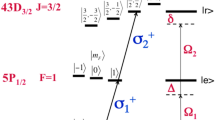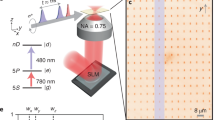Abstract
Owing to their large size, Rydberg atoms are promising tools for quantum technologies1,2, as they exhibit long-range dipole–dipole interactions and strong coupling to external fields. Recent experiments have demonstrated their appeal for quantum simulation purposes3,4,5, even though the relatively short lifetime of optically accessible Rydberg levels imposes limitations. Long-lived circular Rydberg states6,7 may provide a solution. However, the detection of circular states involves either destructive6 or complex7 measurement techniques. Moreover, so far, alkali circular states have been manipulated only by microwave fields, which are unable to address individual atoms. The use of circular states of a different group of atoms, the alkaline-earth metals, which have an optically active second valence electron, can circumvent these problems. Here we show how to use the electrostatic coupling between the two valence electrons of strontium to coherently manipulate a circular Rydberg state with optical pulses. We also exploit this coupling to map the state of the Rydberg electron onto that of the ionic core. This experiment opens the way to a state-selective spatially resolved non-destructive detection of circular states and to the realization of a hybrid optical–microwave platform for quantum technology.
This is a preview of subscription content, access via your institution
Access options
Access Nature and 54 other Nature Portfolio journals
Get Nature+, our best-value online-access subscription
$29.99 / 30 days
cancel any time
Subscribe to this journal
Receive 12 print issues and online access
$209.00 per year
only $17.42 per issue
Buy this article
- Purchase on Springer Link
- Instant access to full article PDF
Prices may be subject to local taxes which are calculated during checkout




Similar content being viewed by others
Data availability
The datasets generated during the current study are available from the corresponding author upon reasonable request. Source data are provided with this paper.
References
Saffman, M., Walker, T. G. & Mølmer, K. Quantum information with Rydberg atoms. Rev. Mod. Phys. 82, 2313–2363 (2010).
Adams, C. S., Pritchard, J. D. & Shaffer, J. P. Rydberg atom quantum technologies. J. Phys. B 53, 012002 (2020).
Scholl, P. et al. Quantum simulation of 2D antiferromagnets with hundreds of Rydberg atoms. Nature 595, 233–238 (2021).
Ebadi, S. et al. Quantum phases of matter on a 256-atom programmable quantum simulator. Nature 595, 227–232 (2021).
Signoles, A. et al. Glassy dynamics in a disordered Heisenberg quantum spin system. Phys. Rev. X 11, 011011 (2021).
Nguyen, T. L. et al. Towards quantum simulation with circular Rydberg atoms. Phys. Rev. X 8, 011032 (2018).
Cohen, S. R. & Thompson, J. D. Quantum computing with circular Rydberg atoms. PRX Quantum 2, 030322 (2021).
Altman, E. et al. Quantum simulators: architectures and opportunities. PRX Quantum 2, 017003 (2021).
Bakr, W. S., Gillen, J. I., Peng, A., Fölling, S. & Greiner, M. A quantum gas microscope for detecting single atoms in a Hubbard-regime optical lattice. Nature 462, 74–77 (2009).
Cheuk, L. W. et al. Quantum-gas microscope for fermionic atoms. Phys. Rev. Lett. 114, 193001 (2015).
Blatt, R. & Roos, C. F. Quantum simulations with trapped ions. Nat. Phys. 8, 277–284 (2012).
Bohnet, J. G. et al. Quantum spin dynamics and entanglement generation with hundreds of trapped ions. Science 352, 1297–1301 (2016).
Zhang, J. et al. Observation of a many-body dynamical phase transition with a 53-qubit quantum simulator. Nature 551, 601–604 (2017).
Barredo, D., Lienhard, V., de Léséleuc, S., Lahaye, T. & Browaeys, A. Synthetic three-dimensional atomic structures assembled atom by atom. Nature 561, 79–82 (2018).
Hulet, R. G. & Kleppner, D. Rydberg atoms in ‘circular’ states. Phys. Rev. Lett. 51, 1430 (1983).
Cardman, R. & Raithel, G. Circularizing Rydberg atoms with time-dependent optical traps. Phys. Rev. A 101, 013434 (2020).
Bounds, A. D. et al. Rydberg-dressed magneto-optical trap. Phys. Rev. Lett. 120, 183401 (2018).
Wilson, J. et al. Trapping alkaline earth Rydberg atoms optical tweezer arrays. Phys. Rev. Lett. 128, 033201 (2022).
Lochead, G., Boddy, D., Sadler, D. P., Adams, C. S. & Jones, M. P. A. Number-resolved imaging of excited-state atoms using a scanning autoionization microscope. Phys. Rev. A 87, 053409 (2013).
Madjarov, I. S. et al. High-fidelity entanglement and detection of alkaline-earth Rydberg atoms. Nat. Phys. 16, 857–861 (2020).
McQuillen, P., Zhang, Z., Strickler, T., Dunning, F. B. & Killian, T. C. Imaging the evolution of an ultracold strontium Rydberg gas. Phys. Rev. A 87, 013407 (2013).
Teixeira, R. C. et al. Preparation of long-lived, non-autoionizing circular Rydberg states of strontium. Phys. Rev. Lett. 125, 263001 (2020).
Itano, W. External-field shifts of the 199Hg+ optical frequency standard. J. Res. Natl Inst. Stand. Technol. 105, 829–837 (2000).
Jiang, D., Arora, B. & Safronova, M. S. Electric quadrupole moments of metastable states of Ca+, Sr+, and Ba+. Phys. Rev. A 78, 022514 (2008).
Leibfried, D., Blatt, R., Monroe, C. & Wineland, D. Quantum dynamics of single trapped ions. Rev. Mod. Phys. 75, 281–324 (2003).
Lehec, H., Hua, X., Pillet, P. & Cheinet, P. Isolated core excitation of high-orbital-quantum-number Rydberg states of ytterbium. Phys. Rev. A 103, 022806 (2021).
Trautmann, A. et al. Spectroscopy of Rydberg states in erbium using electromagnetically induced transparency. Phys. Rev. Res. 3, 033165 (2021).
Ye, S. et al. Production of very-high-n strontium Rydberg atoms. Phys. Rev. A 88, 043430 (2013).
Gallagher, T. F., Kachru, R. & Tran, N. H. Radio frequency resonance measurements of the Ba 6sng–6snh–6sni–6snk intervals: an investigation of the nonadiabatic effects in core polarization. Phys. Rev. A 26, 2611–2622 (1982).
Poirier, M. & Semaoune, R. Analysis of electronic correlations in large-angular-momentum states using the Coulomb Green’s function: positions of low doubly excited states in alkaline-earth atoms. J. Phys. B 31, 1443–1461 (1998).
Acknowledgements
We thank I. Dotsenko for experimental support. Financial support from the Agence Nationale de la Recherche under the project ‘SNOCAR’ (167754, S.G.) is gratefully acknowledged. This publication has received funding from the European Union’s Horizon 2020 under grant agreement no. 786919 (Trenscrybe, M.B.) and no. 765267 (QuSCo, A.M.).
Author information
Authors and Affiliations
Contributions
A.M., L.L., A.C., R.C.T., J.-M.R., M.B. and S.G. contributed to the experimental set-up. S.G. and M.P. performed the numerical simulations. A.M., L.L., A.C. and S.G. collected the data and analysed the results. M.B. and S.G. jointly supervised the experiment. All authors discussed the results and the manuscript.
Corresponding author
Ethics declarations
Competing interests
The authors declare no competing interests.
Peer review
Peer review information
Nature Physics thanks the anonymous reviewers for their contribution to the peer review of this work.
Additional information
Publisher’s note Springer Nature remains neutral with regard to jurisdictional claims in published maps and institutional affiliations.
Extended data
Extended Data Fig. 1 Experimental sequences and energy levels.
Left panels: Precise timing of the laser and MW pulses applied after the circular state preparation. The dashed-blue, dashed-orange and solid-red rectangles show the 422 nm laser pulse, the resonant 1,092 nm repumper pulse and the Raman pulses respectively. The solid-green, dashed-purple and solid-magenta rectangles represent the microwave pulses resonant with the 51c → 50c, 51c → 49c and 51c → 53c transitions respectively. Note that the dashed rectangles represent pulses for which the atom-field interaction time is limited by the transit time of the atom through the corresponding laser or microwave mode and is thus shorter than the pulse duration. (a) Microwave spectroscopy : the optical pumping pulses are followed by a 15 μs-long microwave pulse resolving the differential shift induced by the quadrupole effect. (b) Raman laser spectroscopy of the nc,4d3/2,∣mj∣ = 3/2 → nc,4d3/2,∣mj∣ = 1/2 transition: the 422 nm optical pumping pulse takes place while a π-polarized repumper 1,092 nm laser is on. We then apply the 1,092 nm Raman pulses, followed by an ionic-core state-selective microwave pulse. (c) Optical switch experiment: after removing the residual 51c, 5s1/2 atoms (green pulses) we apply two microwave π/2 pulses (purple) before and after the Raman pulse. A final 51c → 53c pulse (magenta) is used to reduce the background due to the imperfect circular state preparation (see Methods). (d) Energy levels (black lines) and coupling induced by the σ and π components of the 1,092 Raman laser beams (dark red arrows). The dashed arrows correspond to non-resonant processes which do not contribute to the dynamics.
Extended Data Fig. 2 Determination of δn.
Values of the Raman detuning δ inducing a resonant transfer from nc, 4d3/2, ∣mj∣ = 3/2 to nc,4d3/2,∣mj∣ = 1/2 for different powers of the 1,092 nm light and different values of n [n = 49 (black), n = 51 (red) and n = 53 (green)]. The points are experimental and the error bars represent the uncertainty of the fit. The ratio between the intensities of the π and σ components is 1.3:1, which induces a differential light shift proportional to the total intensity. To determine δn, we thus linearly extrapolate the value of the resonant detuning at zero intensity (solid lines).
Extended Data Fig. 3 Filtering of the 51c5s1/2 atoms.
Ramsey fringes on the 50c - 51c transition for an atom initially in the 51c5s1/2 state (black) or in a mixture of 51c4d3/2 sublevels (red). The points are experimental with statistical error bars, the solid lines are the result of fit to a sine. The spacing between the microwave π/2 pulses is chosen so that the fringes are exactly in phase opposition. The atoms in the state 51c are detected using a probe tuned on the 51c → 53c transition. This ensures that non-circular n = 51 states, present due to the imperfection of the preparation process, do not contaminate the signal. This enables us to better estimate the efficiency of the interference filter. For a frequency of 51.098516 GHz, 95 % of the 51c5s1/2 atoms are transferred to the n = 50 manifold, while 94 % of the 51c4d3/2 remains in n = 51.
Extended Data Fig. 4 Rabi oscillations induced by the Raman pulse.
Population π3/2 of the 51c,4d3/2,∣mj∣ = 3/2 levels (upper panel, red points) and the 49c,4d3/2,∣mj∣ = 3/2 levels (lower panel, black points) as a function of the Raman laser pulse duration for a detuning δ = δ*. The points are experimental, the line is a fit to the data using an exponentially damped sine function. The dashed line indicates the optimal pulse duration in the experiment.
Extended Data Fig. 5 Tuning of the phase shift induced by the Raman pulse.
Probability to detect the atom in the 49c state at the end of the Ramsey sequence with the 1,092 nm Raman pulses for δ = 910 kHz (green), δ = 900 kHz (red), δ = δ* = 890 kHz (blue), δ = 880 kHz (cyan) and without 1,092 nm pulse (black). The points are experimental with statistical error bars, the lines are a sine fit to the data. For this laser power, the 49c,4d3/2,∣mj∣ = 3/2 → 49c,4d3/2,∣mj∣ = 1/2 transition is resonant at δ = 913 kHz.
Source data
Source Data Fig. 2
Statistical Source Data
Source Data Fig. 3
Statistical Source Data
Source Data Fig. 4
Statistical Source Data
Source Data Extended Data Fig. 2
Statistical Source Data
Source Data Extended Data Fig. 3
Statistical Source Data
Source Data Extended Data Fig. 4
Statistical Source Data
Source Data Extended Data Fig. 5
Statistical Source Data
Rights and permissions
About this article
Cite this article
Muni, A., Lachaud, L., Couto, A. et al. Optical coherent manipulation of alkaline-earth circular Rydberg states. Nat. Phys. 18, 502–505 (2022). https://doi.org/10.1038/s41567-022-01519-w
Received:
Accepted:
Published:
Issue Date:
DOI: https://doi.org/10.1038/s41567-022-01519-w
This article is cited by
-
A spotlight on circular states
Nature Physics (2022)



